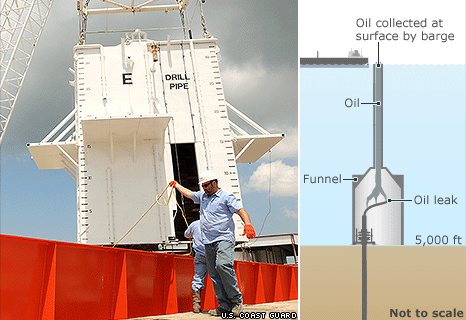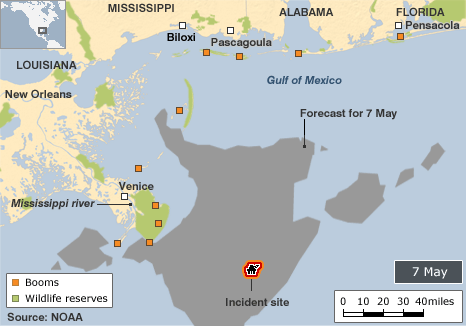BP sends giant box to contain Gulf of Mexico oil spill
A ship carrying a giant metal containment box has arrived at the site where a sunken oil rig has been leaking oil into the Gulf of Mexico.
Oil giant BP says it hopes the 90-tonne device will help to contain the oil.
The US is to carry out a controlled burn of some of the leaked oil. But the oil reached a beach for the first time on Thursday, officials confirmed.
The spill was set off by an explosion that destroyed the Deepwater Horizon rig off Louisiana last month.
Eleven rig workers died in the explosion, and the ensuing oil leak has since been threatening several southern US states.
Coast Guard Petty Officer Connie Terrell said teams from the operation Unified Command in Robert, Louisiana, had confirmed oil on the beach, at the south end of the Chandeleur Islands, at Freemason Island.
“This is the first confirmation that Unified Command has received of oil on a shoreline,” Ms Terrell said.
“It’s largely just sheen, there is no evidence of medium or heavy oil,” she said.

Complicated operation
Remote-controlled submarines will now be used to lower the containment device over the leak.
The operation to fix the massive funnel in place is expected to take two days, and a further two days will be required to connect it to a ship above via a drill-pipe.
If the operation is successful, BP hopes to begin pumping oil to the surface early next week.
BP has never deployed such a structure at a depth of 5,000ft (1,500m) and difficulties may occur, said BP Chief Executive Tony Hayward.
Mr Hayward gave no prediction as to when the oil leak would be stopped, or how much the clean-up operation will ultimately cost.
He denied his company had been slow to react to the disaster, saying BP had mobilised immediately to contain the threat, and adding that it was working with US authorities to contain the spill.
“It’s a military operation and we are thinking of it as a battle on three fronts: beneath the sea, in the sea, and on the shore,” said Mr Hayward.
He said efforts to protect the southern US coastline were going well, with 100 ships involved in an operation to skim oil from the sea’s surface - including 20 of the world’s largest skimming vessels.
Thousands of feet of boom were being used as a barrier to contain the slick and a small air force was deploying dispersants, he added.
Some 4,000 volunteers were being paid $10 an hour to help defend the beaches, he said.
A sheen of oil has already reached the shore in parts of Louisiana, but officials say coagulated crude oil is not expected to reach coastal areas until the end of the week.
The National Oceanic and Atmospheric Administration (NOAA) said the oil slick was not expected to move much in the next several days.
Wildlife concerns
Earlier, BP said it had managed to seal the smallest of the three leaks spilling oil into the Gulf of Mexico.
Oil is still gushing into the sea at a rate of about 800,000 litres (176,000 imperial gallons) a day, but officials say working with only two leaks makes tackling the spill easier.
Favourable weather conditions have now allowed crews to begin burning off more of the oil where it is most heavily concentrated, AP said.
A burn was last tried on 28 April when thousands of litres of oil were successfully removed.
Concerns for the impact of the burn on wildlife in the area have been dismissed by the body co-ordinating the response to the spill.
BP has told members of a US congressional committee that up to 9.5m litres a day could spill if the leaks worsen.

Oil giant BP says it hopes the 90-tonne device will help to contain the oil.
The US is to carry out a controlled burn of some of the leaked oil. But the oil reached a beach for the first time on Thursday, officials confirmed.
The spill was set off by an explosion that destroyed the Deepwater Horizon rig off Louisiana last month.
Eleven rig workers died in the explosion, and the ensuing oil leak has since been threatening several southern US states.
Coast Guard Petty Officer Connie Terrell said teams from the operation Unified Command in Robert, Louisiana, had confirmed oil on the beach, at the south end of the Chandeleur Islands, at Freemason Island.
“This is the first confirmation that Unified Command has received of oil on a shoreline,” Ms Terrell said.
“It’s largely just sheen, there is no evidence of medium or heavy oil,” she said.

Complicated operation
Remote-controlled submarines will now be used to lower the containment device over the leak.
The operation to fix the massive funnel in place is expected to take two days, and a further two days will be required to connect it to a ship above via a drill-pipe.
If the operation is successful, BP hopes to begin pumping oil to the surface early next week.
BP has never deployed such a structure at a depth of 5,000ft (1,500m) and difficulties may occur, said BP Chief Executive Tony Hayward.
Mr Hayward gave no prediction as to when the oil leak would be stopped, or how much the clean-up operation will ultimately cost.
He denied his company had been slow to react to the disaster, saying BP had mobilised immediately to contain the threat, and adding that it was working with US authorities to contain the spill.
“It’s a military operation and we are thinking of it as a battle on three fronts: beneath the sea, in the sea, and on the shore,” said Mr Hayward.
He said efforts to protect the southern US coastline were going well, with 100 ships involved in an operation to skim oil from the sea’s surface - including 20 of the world’s largest skimming vessels.
Thousands of feet of boom were being used as a barrier to contain the slick and a small air force was deploying dispersants, he added.
Some 4,000 volunteers were being paid $10 an hour to help defend the beaches, he said.
A sheen of oil has already reached the shore in parts of Louisiana, but officials say coagulated crude oil is not expected to reach coastal areas until the end of the week.
The National Oceanic and Atmospheric Administration (NOAA) said the oil slick was not expected to move much in the next several days.
Wildlife concerns
Earlier, BP said it had managed to seal the smallest of the three leaks spilling oil into the Gulf of Mexico.
Oil is still gushing into the sea at a rate of about 800,000 litres (176,000 imperial gallons) a day, but officials say working with only two leaks makes tackling the spill easier.
Favourable weather conditions have now allowed crews to begin burning off more of the oil where it is most heavily concentrated, AP said.
A burn was last tried on 28 April when thousands of litres of oil were successfully removed.
Concerns for the impact of the burn on wildlife in the area have been dismissed by the body co-ordinating the response to the spill.
BP has told members of a US congressional committee that up to 9.5m litres a day could spill if the leaks worsen.

You can return to the main Market News page, or press the Back button on your browser.

